Article by Andrew McDonald, England
There is an old story, told in different forms throughout history, that when mankind reaches a low point in our activities down here on Earth, a messenger from God will be sent from the Heavens to show us the way, to show us how to do things properly.
And so it was in the world of art, when, in the year 1474, ‘the benign ruler of heaven,’ saw fit to send us, ‘an artist who would be skilled in each and every craft.’ An artist, ‘whose work alone would teach us how to obtain perfection in design.’
The sending of such a genius, we imagine, would be trumpeted in the stars, and it was, as Giorgio Vasari (16th century artist/biographer) in the second edition of his book, Lives of the Most Excellent Sculptors, Painters and Architects, goes on to tell us: ‘under a fateful and lucky star, the virtuous and noble wife of Lodovico Buonarroti gave birth to a baby son,’ his father saw in him something, ‘supernatural and beyond human experience.’ ‘This was evident in the child’s horoscope,’ and that, ‘his mind and hands were destined to fashion sublime works of art.’ That genius was known as The Divine Michelangelo. Michelangelo Buonarroti.
His birth data has been disputed as to whether it was 1474 or 1475 because of old style or new style calendar as there is a year difference between the two ways of calculating the date. Almost all recent art historians now favour 1475. But Benedetto Varchi, the Florentine historian, who gave the eulogy at Michelangelo’s funeral, Vasari and Ascanio Condivi, another biographer, all give 1474. So does Michelangelo’s father’s record, which survives in a 17th century copy with an added note in brackets, essentially saying, ‘old style not new.’ But the record is a copy, and of course nobody knows when this comment was added. Besides all this, if we let the astrology speak and set the chart for the time suggested by Vasari/Varchi/Condivi and Michelangelo’s father, it fits his contemporaries’ astrological description which the 1475 chart does not. And if we delve further, it speaks eloquently. In short, the astrology stacks up.
The earliest astrological description we have is in Condivi’s biography, Life of Michelangelo Buonarroti. This was published in Rome in 1553 and written with Michelangelo’s guidance. In fact, in a letter dated 14 April 1548, Michelangelo had written from Rome to his nephew Leonardo asking for a copy of his ‘nativita’.
Condivi states: (Michelangelo was born) ‘in the year of our Salvation 1474 on the sixth day of March, four hours before daylight on a Monday. A fine nativity truly, which showed how great the child would be and of how noble a genius; for the planet Mercury and Venus in seconda being received into the house of Jupiter with benign aspect, promised what afterward followed.’
‘Four hours before daylight’ is approx 2 am which we would now call the 7th March but it is still the ‘sixth day of March’ until sunrise, the sixth day lasting from 6 March sunrise to 7 March sunrise. It is also a Monday following the Paschal calendar as Condivi and Michelangelo’s father both noted.
Michelangelo Natal Chart: 7 March 1474 AD JC, 2:06 am, Caprese Michelangelo, Italy
But however we count it, the point is, it fits his contemporaries’ description of his nativity.
Around this time we have a choice of Jupiter or Saturn as Lord Ascendant. The Lord Ascendant is the planet that rules the sign on the Ascendant, from this, and the Ascendant itself, we can judge the physical appearance of the native. I have set it for 2:06am with Capricorn rising, as Saturn in Cancer as Lord Ascendant, fits the description that Condivi gives us in his biography, far more than Jupiter in Capricorn: He was, ‘of middle height,’ with a ‘round skull, (prominent) square forehead,’ ‘little eyes,’ ‘flattened (broken) nose,’ ‘few eyebrow hairs,’ and ‘hair black and not very thick.’ Condivi also mentions, ‘He suffered for many years with difficulty in passing urine’. This, for our purposes, points to restrictive Saturn in watery Cancer in the seventh house of his pelvis and genitals, trine by the Moon in its fall in a fixed water sign.

Traditionally planets are said to be in certain ‘dignities’ depending on their location in the chart. These dignities are known as ‘essential’ and ‘accidental’. Essential dignities are derived from the sign in which the planet falls, in some places they are ‘good’ strong or ‘happy’ shown by a planet falling in its own sign, exaltation or triplicity, and to lesser extent term and face. In others they are problematic, weak or unhappy shown by a planet in its detriment or fall. These distinctions are also qualitative and so we can also see a planets attitude toward other planets by essential dignities. For example, if a planet falls in the exaltation of another then it exalts whatever that particular planet signifies. If it is in another’s sign then it is ruled by or ‘loves’ that planet. In another’s detriment it dislikes that planet, in its fall; it hates it. This technique is called ‘reception’. Planets that are simultaneously in each others dignities are in ‘mutual reception’ signifying understanding between them. This can be positive or negative depending on the state of the planets and the dignities involved.
Accidental dignities basically show how much ability a planet has to act in the world, this is shown by various factors such as its position in the houses, aspects by other planets, speed and direction, placement on fixed stars etc.
Using this time of 2:06am for Michelangelo’s birth, the planet Jupiter is inside the first house, this could be seen literally as the ‘fateful and lucky star’ that Vasari mentions, Jupiter traditionally being known as the great benific and thus, lucky. Though, of course, Vasari may have been speaking generally about the auspicious astrological moment Michelangelo was born. Any planet in the first house close to the ascendant will have some affect on the native’s appearance, the native being ‘born under’ it. But this will only qualify, it will not change the primary testimonies, these are drawn from the Ascendant and Lord Ascendant, so as a first choice between Saturn and Jupiter as Ascendant ruler, one must go with Saturn in Cancer.
A quick look at the chart reveals the thoughtful, contemplative Melancholic nature Michelangelo was known for. His Ascendant, Lord Ascendant and Moon are all judged as cold and dry by traditional method, thus giving him a Melancholic temperament.
He was generous by nature, benific Jupiter is in his first house and so is significator of his manner, of his motivations. This generosity was very important to him as shown by his Lord Ascendant exalting this Jupiter and can be seen by the work he sometimes just gave away. For example, the statues, The Dying Slave and The Rebellious Captive that are now in the Louvre in Paris, he simply gave to his friend Roberto Strozzi. Also Condivi quotes him: ‘rich man as I have made myself I have always lived as a poor one.’ Michelangelo’s Lord Ascendant Saturn is in its detriment in Cancer, sign of the ‘poor and common people.’ He was a devout Christian: his significator of manner, Jupiter is on the fixed star Pelagus. Vivian Robson in his book: The Fixed Stars and Constellations tells us that Pelagus gives the native, ‘a religious mind and ecclesiastical preferment.’ And as Condivi tells us, Michelangelo had a great affection for the famous Florentine preacher Girolamo Savonarola, ‘keeping always in mind the sound of his voice.’ With the ruler of his 9th house of religion being in a fixed, ‘voiced’ sign, this should not surprise us.
If a planet falls in the exaltation of another then it exalts whatever that particular planet signifies. If it is in another’s sign then it is ruled by or ‘loves’ that planet. In another’s detriment it dislikes that planet, in its fall; it hates it. This technique is called ‘reception’. Planets that are simultaneously in each others dignities are in ‘mutual reception’ signifying understanding between them.
The Moon and Mercury are traditionally seen as the rulers of a natives mind and their condition and relationship with each other describe the particular qualities that mind has. Michelangelo’s show his ingeniousness: his Mercury is conjunct fixed star Deneb Adige, which, according to Robson, whose book is the standard traditional text on the fixed stars, ‘gives an ingenious nature and clever intellect.’ His Moon is conjunct the North Node. William Lilly, the great 17th century astrologer, in his indispensable book Christian Astrology points out, this position of the Moon ‘shows active spirits, prompt to any science’. The Moon and Mercury behold each other by a square aspect giving ruggedness to his mind, and Mercury is below the horizon, a position that particularly frames his mind for the Arts.
Michelangelo’s Moon and Mercury are also conjunct by the traditional method of ‘antiscion’. This is whereby a planet is reflected through the solstice points of 0 degrees Cancer and 0 degrees Capricorn, thus giving the planet an alternate or second placement. This is traditionally read in much the same way as a bodily position and according to William Lilly this conjunction of Mercury and Moon ‘in any sign, declares ingenious persons’.
His art is powerful and passionate: more planets are in Mars dignities than the dignities of any other planet. Mars rules the Moon, which as it is a night time birth, is known as the ‘Light of Time’. Venus is his ‘Lord of the Geniture’, the strongest planet by essential and accidental dignities in his chart. Venus is the natural ruler of art and is powerful, having just entered her exaltation in Pisces. It is in the second house with Mercury, in mutual reception and sextile (‘benign’) aspect with Jupiter; exactly as Condivi had noted. Venus is also conjunct his Midheaven, his place of work, by antiscion and is ruler of his 10th house of action.
Traditionally the eclipse before birth will show the ‘life and times’ in the mundane world, the big wide world that the native is born into. It is set for the latitude and longitude of birth thus linking it to that particular place. It can be seen as a set of potentials, if a native sets himself out from the crowd, somehow he will plug into these potentials shown by the eclipse before birth, attempting to bring to fruition the seeds that are planted there. This will be shown by significant points or planets in the natal chart falling on significant places in the eclipse chart. After the eclipse and before birth there may also be a pre birth lunation; a New or Full Moon. This seems to act as a narrowing of focus as if the manifestation of the potentials of the eclipse are now restricted to less possibilities and these possibilities are then further restricted by the birth chart. Connections are seen or not seen between the charts and this is all read back into the potential that is shown in the ‘bigger Picture’ of the eclipse. Only what is shown there can be achieved.
With our eyes open to these connections we can see Michelangelo’s Light of Time, the Moon, powerfully applying to conjunction with the benific North Node in the 10th house of his career and, by antiscion, this falls on the Mercury and Venus conjunction of the pre birth lunation. His Mercury also picks this up, plugging him in to the life and times of his era and fuelling his powerful artistic imagination. Mercury is ruler of his 9th house of visions and dreams and is on fixed star Deneb Adige so favourable for artists. Venus gives him the eloquence and Mercury provides the facility to portray the cosmic vision, to bring it to earth. The pre birth conjunction of Mercury and Venus occurs in Aquarius, traditionally seen as the most ‘humane’ of signs and ruled by Saturn, who in turn is traditional ruler of matter, marble and stone. Poetry was another of Michelangelo’s artistic gifts, Venus providing Mercury with the poeticism to speak beyond the mundane; Aquarius is fixed air and is a voiced sign.
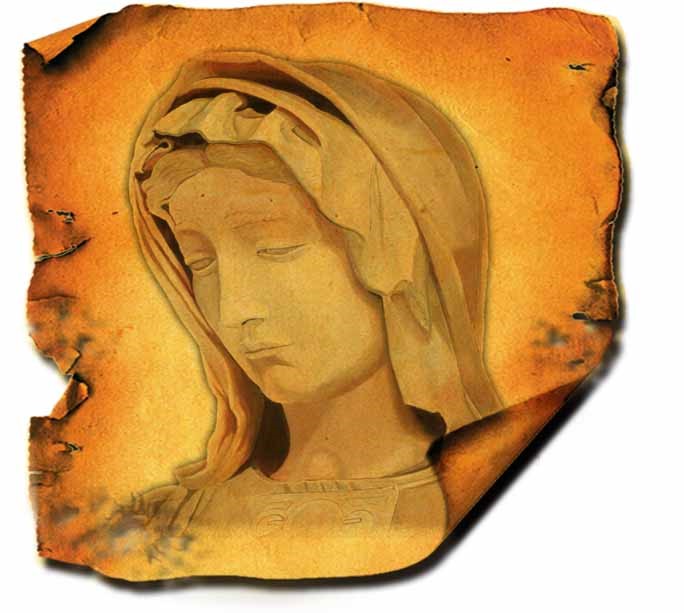
His work will make its mark on the world: Michelangelo’s 10th house/4th house axis, known as the MC/IC, reverses the MC/IC of the pre birth eclipse. As the MC is the heavens, the IC can be seen as the lowest point, the ground, or the world down here. It will be through Art, and the portrayal of the divine and the human that he will make his mark: his Sun, by antiscion, is conjunct the ruler of the eclipse, a dignified, and again humane, Venus. His creations, shown by Venus as ruler of his 5th house, are of an exalted religious nature as Venus is exalted in Pisces, a Jupiter sign and Jupiter being the traditional ruler of Religion. They are in mutual reception, showing understanding between them and in sextile aspect, again showing influence and access to one another. His Midheaven is on the fixed star Princeps, which is located on the spear shaft of Bootes, said to give a profound mind. As this star is on his MC, this profundity will come out in his career. That it is on the spear shaft shows again it is aspiration, in the best sense of the word that is driving the career, as the spear shaft is thrust up towards the Heavens. Princeps can also show him working for ‘Princes,’ which of course, he did.
He has a great love and understanding of religion, shown by his Lord Ascendant Saturn, exalting, and in mutual reception, understanding, with Jupiter, natural ruler of religion. Jupiter as mentioned above is on Pelagus. Pelagus is situated on the vane of the arrow at the archer’s hand, and so shows him aiming for the heavens, aspiring. Yet even someone as great as Michelangelo can only ‘see’ so far: fixed star Facies conjunct his Ascendant will obscure his view.
Saturn is conjunct Alhena a Venus/Mercury fixed star, favourable for artists and artistic expression, in the seventh house of other people, thus, portraying visions directly to them in the ‘plastic’ materials, (Saturn in Cancer) of Art.
Exalting Jupiter, this artist will favour a large, grand vision, Jupiter being ruler of large and grand things, attempting to contain, as Saturn is the ruler of boundaries, the uncontainable; Saturn being in Cancer is in uncontainable Cardinal water.
There are problems and injuries to his eyes, as indeed he had while painting the Sistine Chapel ceiling with paint dripping into them. Saturn as lord 2 is seen as his tools, his brushes and paints, and as Saturn is in its detriment they afflict the Moon, ‘his eyes’ by trine. He tells us himself in this extract, from sonnet 5, written while he painted the ceiling:
Saturn is conjunct Alhena a Venus/Mercury fixed star, favourable for artists and artistic expression, in the seventh house of other people, thus, portraying visions directly to them in the ‘plastic’ materials, (Saturn in Cancer) of Art.
…the brush keeps dripping till my face looks gaudy
more like mosaic than anything you’d tread on…
And there were problems after completing the ceiling, as Condivi tells us, when he could no longer lower his eyes, so long had he stared upwards: ‘When he had finished this work Michelangelo, because he had painted so long a time with his eyes turned upward towards the vault, could hardly see any thing when looking down, so that when he had to read a letter or look at a minute object it was necessary for him to hold it above his head.’
Unfortunate fixed star Facies, on his Ascendant, also brings injuries to his eyes, Facies being the nebula on the archers face; as the archer aims upwards to Heaven, so his eyes suffer.
The Sun and Moon, ‘the Lights’ are the traditional rulers of the eyes and his Moon is in its fall afflicted by that trine from Saturn which is also Michelangelo himself. His Sun is exactly conjunct the fixed star Difda, a yellow star on the Whale’s tail. This Whale is Cetus the sea monster sent by Poseidon to ravage the land and devour the beautiful Andromeda, to avenge the claim by Cassiopia, Andromeda’s mother that Andromeda was more beautiful than the sea nymphs the Nereids. And so this Whale, this sea monster, is born from the endless ocean of desires and from envy too, it is driven to ravage the epitome of beauty that is Andromeda who is more beautiful than even desire itself. The hero Perseus intervenes changing the sea monster into stone by showing it the head of Medusa, originally a beautiful young woman, but whose beauty turns all who look at her to stone.
She is born from desire for the material world, being daughter of Pontus, the ocean and Ge earth or matter. Her gaze shows Cetus the sea monster that his origin is in avarice and his nature is the desire to devour material beauty. Michelangelo’s eye is on the tail of this thrashing beast. This is not a fish whose tail is vertical and shares in its steering like a rudder on a boat, this is a mammal and its tail is horizontal, acting as the ‘motor’, the powerhouse or engine room that propels the beast; this is where Michelangelo’s eye is located. With realization of its true nature via the gaze of Medusa, the Whale is transformed into stone. Which on the one hand because of his mighty artistic gifts Michelangelo can turn to his advantage as a sculptor and creator of static images, taking this driving desire for material beauty and capturing and containing it in stone, and on the other hand, later in life, realizing that this can only take him so far, this quest for material beauty, before he realizes one can make an idol of it instead of seeing it for its true nature which is always to lift ones eyes beyond itself, beyond the material. Michelangelo, near the end of his life, wrote sonnet 285, in it he tells us:
Through stormy seas and in a fragile bark my life has reached at last the common port where all must come to render their report, accounting for each good and evil work.
So the fond fantasy that used to make an idol and a tyrant out of art, I now see as it is, with error fraught, like what men love despite the harm they take.
What of these vain and wanton thoughts of love now I approach two deaths? I know that one is certain, and the other threatens me.
Painting and sculpture will no longer serve to calm my soul, turned to that love divine whose arms were opened for us on the cross.
Perseus was riding through the air on Pegasus. That Pegasus was born from the head of Medusa shows that he too is representative of desire. But this desire has wings, lifting him upwards towards the Heavens, aspiring and enabling the hero to slay the beast and free Andromeda. She is now seen, because of the elevation of his desire, as she truly is: a reflection of divine beauty. The hero then marries her. It is clear that Michelangelo managed this feat many times in his long artistic career, both in paint and stone. From the stamp of Pegasus hoof comes the fountain Hippocrene sacred to the muses where poets are said to draw their inspiration. Michelangelo clearly was no stranger to this place either.
Fixed star Bungula sits on his 11th cusp; a Venus/Jupiter star traditionally seen as bringing ‘beneficence, friends, refinement and honour.’ On his 11th cusp these qualities will manifest through his friends: after all, this was the man who spoke familiarly with popes and as a youth wandered sketching and studying in the gardens of the Medici princes under the wing of Lorenzo the Magnificent. Yes indeed, he had powerful friends. The Pope, after Michelangelo’s death, even expressing he wanted ‘a personal memorial and sepulchre for him in St Peter’s itself.’
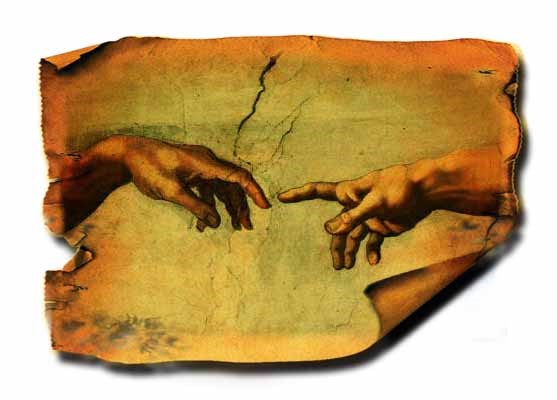
Michelangelo clearly had empathy for others with his Lord Ascendant on the 7th cusp in trine with lord 7, ‘other people’ and his Moon so high in the chart, making his empathy visible. He portrayed humanity as exalting the religious quest back to God, shown by Saturn in the 7th house, exalting Jupiter on Pelagus. These planets are in opposition, showing the tension of separation, they are also in mutual reception showing the possibility of resolution, but they are both essentially debilitated, (as is lord 7), showing the inability to do it by ones self, hence the need for Grace; God reaching down to humanity. This constant theme in his visual work is also shown, especially later in life, in his poetry. In sonnet 292 he cries out:
…The prayers I offer would be sweet indeed If only you would lend me power to pray…
And in sonnet 289
…Stretch down to me, dear Lord, the chain that
with itself brings linked each heavenly gift: I mean
faith that I catch and course at, while I rue
my sin that checks full grace that comes from faith…
The Arabian Part of Vocation falls at 4 degrees Gemini, within 2 degrees of the royal fixed star Aldebaran. It is ruled by Mercury in Aquarius the most humane of signs, and as mentioned, this Mercury (also conjunct his Moon by antiscion) falls conjunct the Mercury/Venus conjunction in the pre birth lunation, giving him the job of articulating the artistic vision of his time. Occurring in a fixed sign shows this is a vision that will last.
That this is for his generation and more is also confirmed by his natal arc Part of Vocation falling exactly conjunct the fifth house of ‘creations’ in the pre birth eclipse, and his natal 5th house cusp is conjunct the eclipse itself on the exalted Moon. This plugged him into the power source of the eclipse.
(The natal arc Part of Vocation is calculated by using the Moon – Sun arc from the nativity and projecting it from the Midheaven of a separate chart. This can be done with the other major parts as well, following the same method; take the natal arc of the planets the Part is derived from and project it from the respective point in the separate chart rather than the natal. It seems to show a deeper working out of things in time – almost at what we would call a ‘Soul’ level.)
His natal Fortuna is conjunct the eclipse Ascendant, focusing its power to earth, the Ascendant being the horizon, and his Sun is conjunct the eclipse 9th house, the house of both Art and God. This was no ordinary artist, he was working for his generation and beyond, as Vasari quoted him when asked by a priest, a good friend of his why he never took a wife so as to leave all his work to his sons, said: ‘I’ve always had too harassing a wife in this demanding art of mine, and the work I leave behind will be my sons.’ How right he was, and how long they would live, his natal 5th cusp, ‘his offspring’ is conjunct the fixed exalted eclipse Moon.
Looking at some momentous episodes in Michelangelo’s life…
The Medici Gardens
In 1508 Francesco Granacci took Michelangelo to the gardens of the Medici of San Marco. Here he met Lorenzo the Magnificent, father of Pope Leo, as Condivi says, ‘a man renowned for every excellence’. Lorenzo had so many beautiful antique statues and decorative sculptures that Michelangelo resolved not to return to the workshop he was apprenticed to and instead study in the gardens of the Medici princes. His progressions for this year show his Moon progressing onto royal fixed star Aldebaran a magnitude 1 powerful star signifying a new beginning for Michelangelo, ‘with those who will bestow many badges of honour upon him,’ (Lilly). The Moon then moves onto his progressed 5th cusp and natal Part of Vocation. This pattern is confirmed by the solar return for this year. Venus is conjunct the Midheaven of pre birth eclipse, and falls into the natal 4th house: ‘the garden’. Saturn, Michelangelo himself, is exalted, conjunct the benific North Node, and an exalted Moon is in the sign of Venus entering the 9th house of study: It seems that he was never happier.
As happy as he was in the gardens of the Medici, he would become equally unhappy in the painting of the Sistine Chapel and yet this was to be one of the triumphs of his career.
The Painting of the Sistine Chapel
Michelangelo did not consider himself to be a painter at all; he ends his sonnet 5 with the words: ‘this is no place for me, and I’m no painter.’ Neither did his rivals consider him to be one. In light of this, how much more remarkable the painting of the Sistine Chapel is.
Michelangelo’s progressed Sun is also opposed to his natal Moon, for which Lilly says will bring the native, ‘dangerous infirmities in the eyes and sickness in other parts of the body, many times sore eyes and a violent fever.’
The painting of the Sistine Chapel ceiling was begun in 1508 and completed in 1512, in which, Michelangelo, ‘has depicted the creation of the world and then almost the whole of the Old Testament’ (Condivi). The work was unveiled on All Saints day 1512 and all Rome came to admire it.
As the ‘Benign Ruler of Heaven’ had sent him, who better to depict the Creation than Michelangelo? Though a look at his progressed Sun for 1508 separating but still opposed to his MC, soon to leave its exaltation and lose all its dignity and then conjunct the unfortunate South Node, one can see it was not a commission he was looking forward to.
In fact his rivals, the architect Bramante and the artist Raphael were plotting in secret. Judging that his principal art was sculpture they had put him forward for the job, convincing Pope Julius, that Michelangelo was the man. Then they waited in the wings for him to fail as they were sure he would, thus destroying his reputation and his friendship and patronage of the Pope. Jupiter is Lord 12, his ‘secret enemies’, and is in Michelangelo’s 1st house influencing him and opposing his Lord Ascendant in the 7th. Jupiter also rules his Arabian Part of Fame. There is mutual reception between them, and between Jupiter and Venus, ruler of his career: his enemies would be influential in his fame.
Michelangelo protested. Condivi tells us: (He) ‘…as yet had never used colours, and knew the painting of the vault to be a very difficult undertaking and tried with all his power to get out of it…’ Pope Julius was not moved and despite Michelangelo’s protestations he insisted. And so Michelangelo set himself to do the work.
Instability, troubles and contentions are shown by his Ascendant progressing onto fixed star Armus, as he is called to exercise his knowledge and art: progressed Ascendant is in early Lord 9 Mercury terms, in humane Aquarius, with his Sun sextile natal Mercury. He is called to ‘voyage’ as his 9th house of ‘Long journeys’ progresses onto fixed star Acrux, a magnitude 1 Jupiter star, the brightest star in the Southern Cross, traditionally bringing religious beneficence. As his natal Lord 9 is in a fixed air sign, and with his contemplative nature and artistic gifts this was to be a voyage of imagination and stunning vision, and his Ascendant had also progressed onto the Descendant of his pre birth eclipse: it was time to capture everybody’s imagination, it was time to capture the zeitgeist.
His enemies would play their part: the solar return for 1508–09 shows an exalted Moon in mundane conjunction with the Jupiter that sits inside Michelangelo’s Ascendant, Jupiter being ruler of his part of Fame and of the 12th house of enemies. It is also opposed to the Jupiter in the return chart.
His gifts are called into play to describe a cosmic drama for all to see: the return Mercury is conjunct his natal Venus and the return 9/3 axis is conjunct his natal Ascendant/Descendant thus bringing his art into the world, or images of heaven (9th) down to earth (3rd) for both himself and others, the 3rd traditionally being seen as the flowering and manifestation of the imagination of the ninth. The 3rd house is also where we see the return’s Fortuna, which is conjunct natal Lord Ascendant, Michelangelo himself and is ruled by strong exalted return Moon.
The return Mercury conjunct his natal Venus brings to mind the Mercury/Venus conjunction in the pre birth lunation (in fixed Aquarius and ruled by Saturn). This time the conjunction is ruled by Jupiter in a fluid, mutable, water sign: it would be paint and not stone that this religious vision would be created with.
This was filled with problems though: natal arc Fortuna falls at 17 Degrees 10 Sagittarius in the return in the eighth house of fear and anxiety. At one time the Pope threatened to throw Michelangelo off the scaffold; the eighth house is also the house of death. This natal arc Part falls into the natal 12th house where Michelangelo felt trapped, the 12th being the ‘place of confinement’ and was in the power of his secret enemies, also shown by the 12th, Bramante and Raphael et al. And trapped he was. When he finished the picture of the Flood the work grew mouldy, again he protested: ‘I have told your holiness that this is not my art; all I have done is spoiled; if you do not believe it, send and see.’ The Pope sent architect Sangallo to inspect it, who said the lime in the fresco was too wet thus causing the problem. ‘Informing Michelangelo of this he made him proceed and the excuse was unavailing.’ (Condivi). Michelangelo continued to finish the work, without assistance, and ‘not even anyone to grind the colours.’ (Condivi).
The progressions for 1512, the year the Sistine Chapel was completed show his Sun conjunct the South Node, between progressed South Node and natal South Node a very unfortunate place to be. William Lilly tells us this progression brings the native, ‘grief and pains in his eyes, many obstructions in the body’. Michelangelo’s progressed Sun is also opposed to his natal Moon, for which Lilly says will bring the native, ‘dangerous infirmities in the eyes and sickness in other parts of the body, many times sore eyes and a violent fever.’ He was in a right state. He couldn’t even bring his eyes downward to see, he had to hold letters above his head to read them.
His 1512 solar return shows the return Ascendant/Descendant axis falling onto his natal Midheaven, and this conjunct the Midheaven of the pre birth eclipse, and so links all the way back to the eclipse as a flowering of the seeds planted there. Return Saturn (natal Lord Ascendant) is loosely conjunct return Moon and both are conjunct natal Moon and natal North Node in the 10th house of career, there is also a mundane conjunction with natal Saturn. It was this painting that lifted him above and beyond any living artist. His enemies must have been beside themselves.
‘And all Rome came to see it…’ (Condivi).
Raphael and Bramante had lost and Michelangelo was honoured as the greatest of all living artists.
The lunar return for the completion, it was unveiled on the feast of All Saints 1512, has its Midheaven conjunct Michelangelo’s Part of Vocation and royal star Aldebaran. Return Lord 9, signifying his art, is conjunct fixed star Wega, traditionally said to bring visions from heaven, and is exalted in the 5th house of the return signifying his creations at that time. It is also conjunct natal Jupiter in his 1st house.
‘It was such to make everyone speechless with astonishment.’ (Vasari). Return lord 7 is in a mute sign exalting Venus who is art and beauty conjunct Michelangelo’s natal Sun, in other words, Michelangelo himself.
He was lifted up above all other living artists: return Mercury natal lord 9, his art and knowledge also ruler of his part of Vocation is conjunct the North Node and Fortuna.
His fame was mighty indeed, and yet there would be another fresco, later in life, in which he ‘excelled the masters,’ and even ‘outstripped himself.’ (Vasari). This was the painting of The Last Judgement.
The Painting Of The Last Judgement
Michelangelo started work on The Last Judgement in 1536. This fresco was painted on the end wall of the Sistine chapel. It was during this time he also composed sonnet 104 which as we can see in this excerpt, is laden with astrological imagery:
He who created time from nothingness
(but after man’s creation, only then)
split time in two: one half held high the sun,
the other had the moon that’s near to us.
From these were born, before the moment passed,
the fortune, fate and chance of every man;
I was assigned the dark time for my own,
as what my birth and cradle suited best.
I copy what I think fate says I am…
Michelangelo’s painting of The Last Judgement was uncovered on the 31st of October 1541 (private view). His Midheaven had progressed onto his Ascendant and his progressed Moon conjuncts the pre birth eclipse Midheaven. His Sun has just progressed into Gemini showing a new phase and his Fortuna is on royal fixed star Fomalhaut, ‘changing material to a spiritual form of expression,’ (Robson). This star is associated with the winter solstice and the birth of Christ. How fitting that this painting would be unveiled to the public on Christmas day.
His solar return for this year shows return Saturn, natal Lord Ascendant, Michelangelo himself, exalted. It is retrograde, going backward, thus showing a return to painting, on his natal Midheaven; at the highest point, in glory, for all to see. A nice fertile return Moon conjuncts natal Saturn, bringing bounty with it, and yet is opposed to natal Jupiter showing the tension and opposition in the work. Natal arc Fortuna is conjunct natal Sun and the return North Node, suggesting his soul’s search to bring his visions of God’s power and majesty was achieved in this, and this all happening on the natal 3rd, again, bringing these visions into manifestation, down to earth, as Vasari, Varchi, Condivi and others would later say. With return Jupiter, ruler of his natal arc Fortuna and natal Part of Fame conjunct powerful royal fixed star Regulus, which leads straight to the throne, we can see this was indeed the work that propelled him in the eyes of his peers, beyond all others living or dead.
The lunar return for the uncovering shows return Sun conjunct Michelangelo’s Moon/North Node natal conjunction. This is powerful; as the Sun is on Acrux, brightest star in the Southern Cross, even more so. We have seen this star before: it is the same star his 9th house had progressed onto with the painting of the Sistine Chapel. Acrux brings him religious beneficence.
Return Jupiter though in its detriment is conjunct Fortuna conjunct return Ascendant which is, in turn, conjunct natal 9th house. Many, like Biagio da Cesena, the master of ceremonies, and so naturally ruled by Jupiter, were unhappy: Jupiter is in its detriment, about Michelangelo’s art: Jupiter is conjunct Michelangelo’s natal 9th house of art. This was because of the nakedness of the people he had depicted, “exposing themselves shamefully,” they felt it was unseemly: Jupiter is in the fall of Venus.
But, despite this, the return Ascendant, Fortuna and Jupiter are all conjunct the full Moon of the pre birth lunation, marking this time as highly significant.
This was to be unlike anything else.
‘…to the wonder and astonishment of the whole of Rome, or rather the whole world.’ (Vasari)
The Public came to see this work Christmas day, December 1541, and were, ‘stupefied by what they saw.’ (Vasari).
The lunar return preceding this event shows the return Ascendant conjunct natal Mars, appropriate, given the power that shocked the populace and not surprisingly, many again, did not receive it well at first. But the return Mars is conjunct fixed star Spica, associated with The Virgin Mary, strongly protective and bringing success and renown. The return North Node is on the return 9th house. A humane Venus, showing Michelangelo’s decorum in painting humanity, is in the 7th house in mundane conjunction with natal Saturn who is natal Lord Ascendant, Michelangelo himself. Return Sun is conjunct natal Ascendant: shining light on Michelangelo and the light of God shining through him, as Vasari and others would later say. His natal arc Part of Vocation is conjunct the return North Node, showing it was part of his vocation to be once again lifted up: natal arc Part of Vocation/North Node conjunction lifts him up, that this is via his art is shown by it being conjunct the return 9th house, to show the world, the 7th house of other people, how to do it.
On Christmas day at 12 noon, with the Sun at it’s zenith, exactly opposite, on the IC, traditionally seen as ‘the end of things’ was Michelangelo’s natal arc Part of Fame: ‘The Last Judgement’. The Moon shows the populace and is square both his Part of Fame and the Sun, so showing the tension between them, and yet exalting the Sun, symbol of God on the Midheaven. To be in square aspect as Ibn Ezra said in his book The Beginning of Wisdom: is a sign of ‘each party seeking control for his self’, in this context the battle between human free will and God’s destiny. Terrified by the square but exalting God, the populace are captured by this tension and power, while the vision, the ruler of natal arc Part of Fame, exalts God Himself. And this noon chart’s Ascendant/Descendant axis falls on the Midheaven of his pre birth eclipse and on the Venus of the Medici gardens, through the Sistine Chapel charts and onto Michelangelo’s natal Midheaven, linking them all through time, like a line between God and man thus bringing vision of the Heavens down to earth, or as Vasari would later put it: ‘enabling mankind to see the fateful results when an artist of sublime intellect infused with Divine Grace and knowledge appears on earth.’
Charts
Pre-birth Eclipse
4 Nov 1473 AD JC
10:00:20 pm
Caprese Michelangelo
Italy
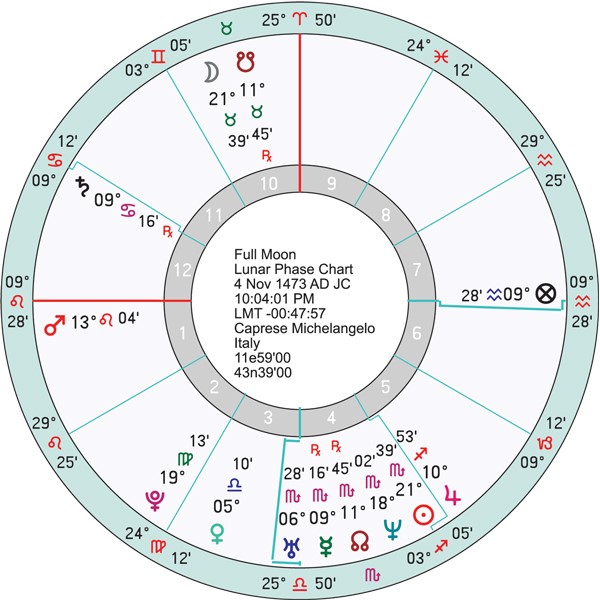
Pre Birth Lunation
3 March 1474 AD JC
11:33:58 pm
Caprese Michelangelo
Italy
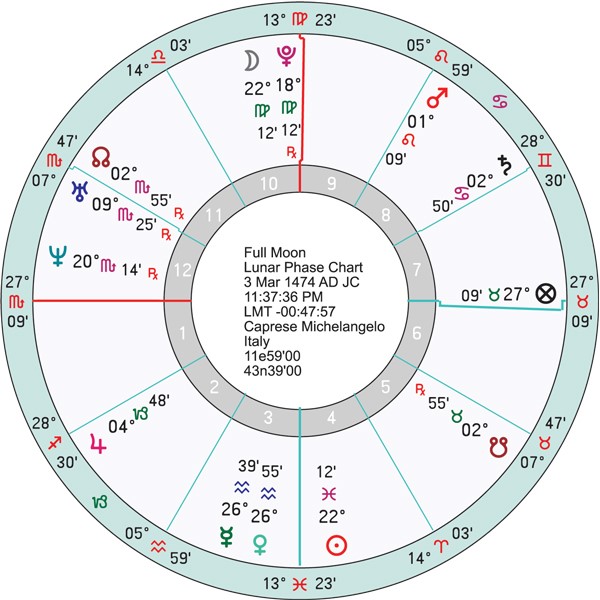
Secondary Prog
Enters Medici household
7 March 1489 AD JC
2:06 am
Caprese Michelangelo
Italy
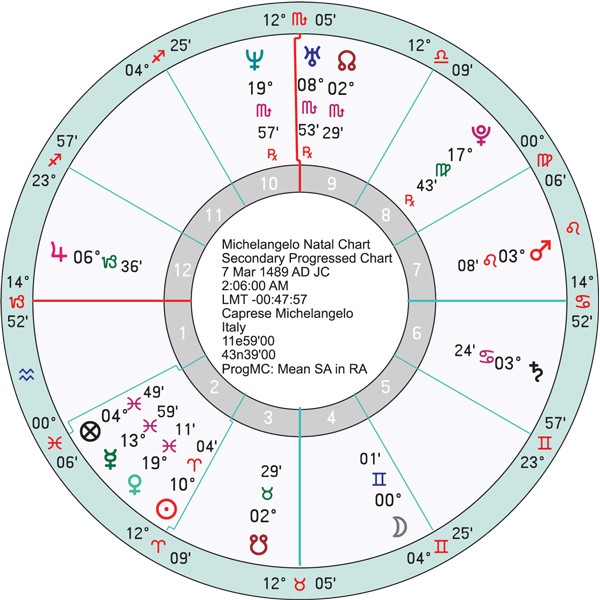
Solar Return
Enters Medici household
6 March 1489 AD JC
5:27:49 pm
Caprese Michelangelo
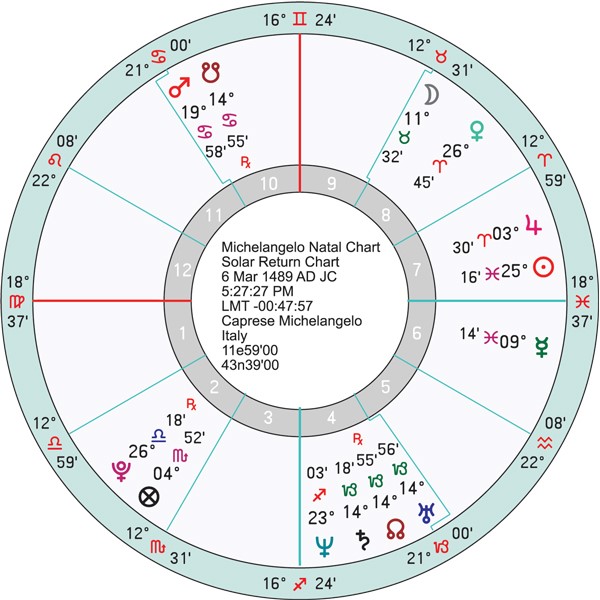
Secondary Prog
Begins Sistine Chapel
7 March 1508 AD JC
5:58:43 pm
Caprese Michelangelo
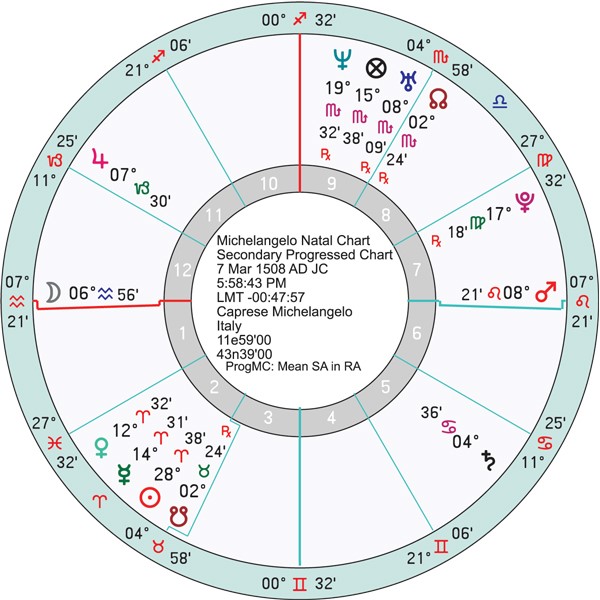
Solar Return
Begins Sistine Chapel
6 March 1508 AD JC
7:57:45 am
Caprese Michelangelo
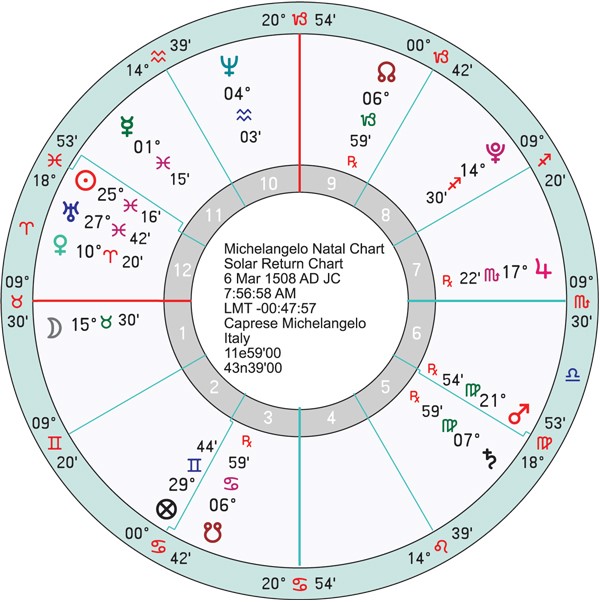
Secondary Prog
Sistine Chapel completed
7 March 1512 AD JC
3:47:07 pm
Caprese Michelangelo
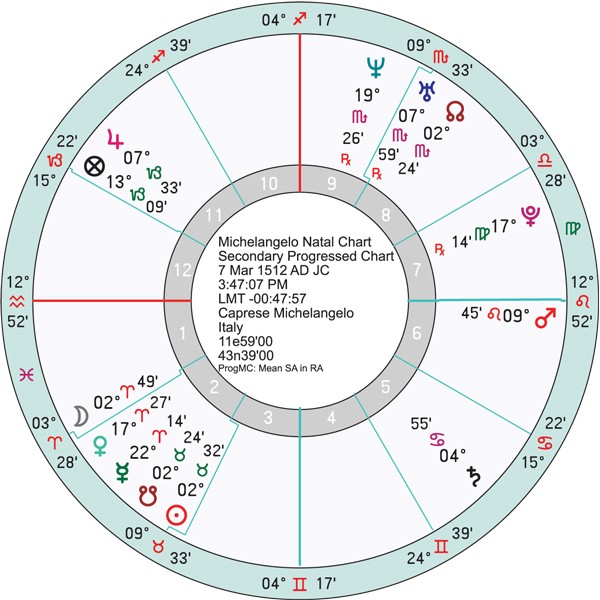
Solar Return
Sistine Chapel completed
6 March 1512 AD JC
7:20:27 am
Caprese Michelangelo
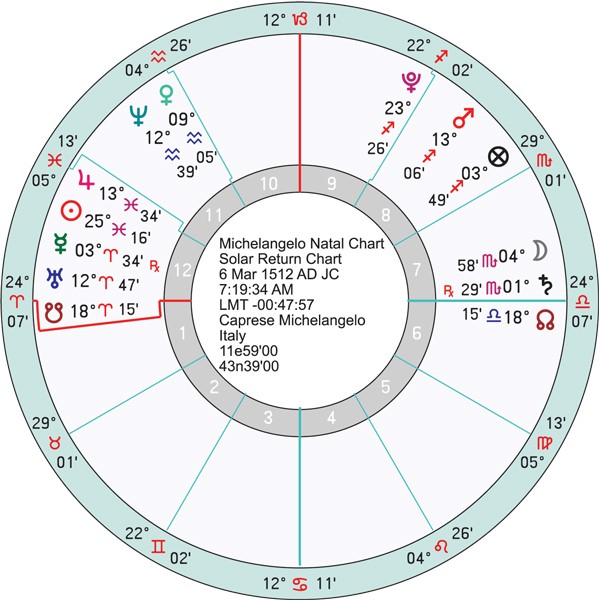
Lunar Return
Sistine Chapel completed
13 Sept 1512 AD JC
3:58:43 am
Caprese Michelangelo
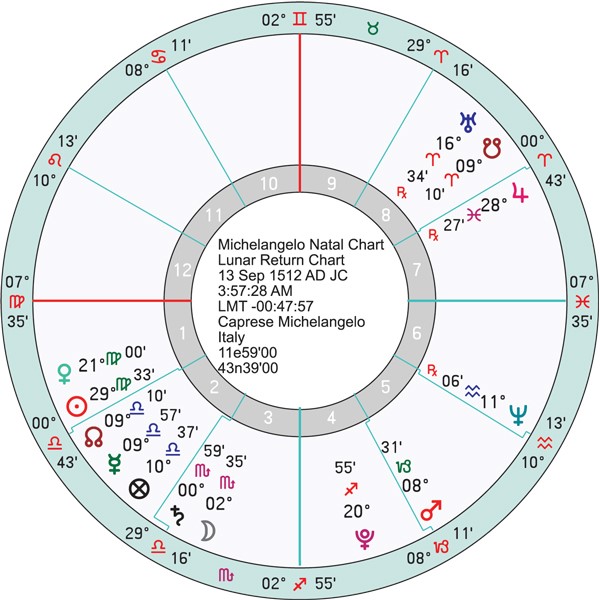
Secondary Prog
Last Judgement uncovered
7 March 1541 AD JC
3:47:07 pm
Caprese Michelangelo
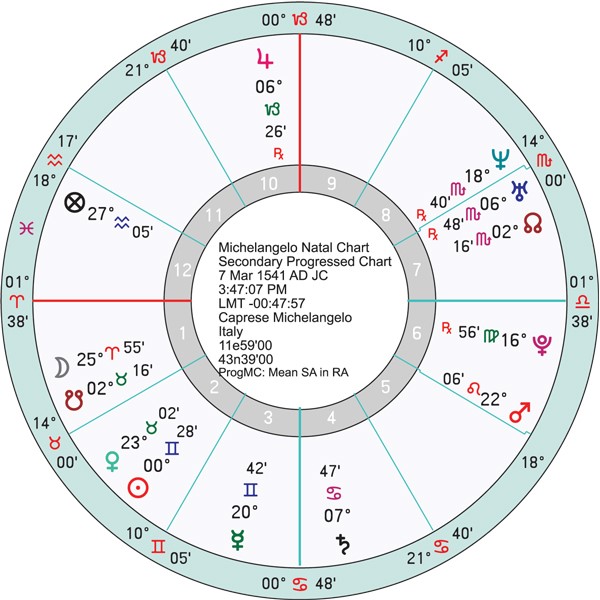
Solar Return
Last Judgement uncovered
6 March 1541 AD JC
7:58:39 am
Caprese Michelangelo
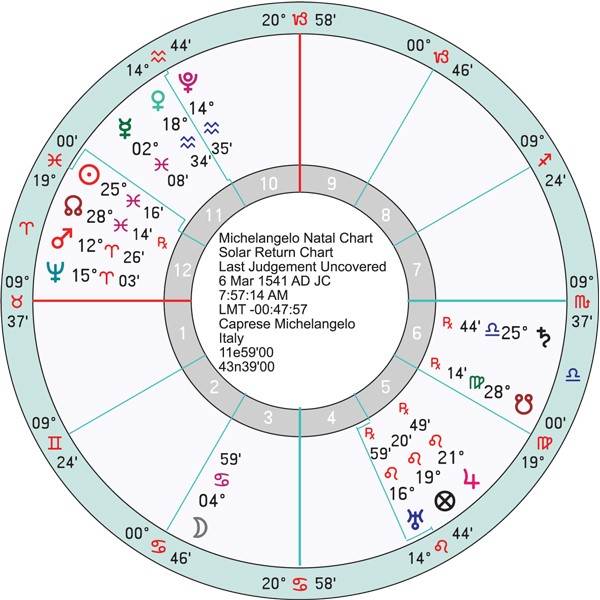
Lunar Return
Last Judgement uncovered
19 Oct 1541 AD JC
3:07:45 am
Caprese Michelangelo
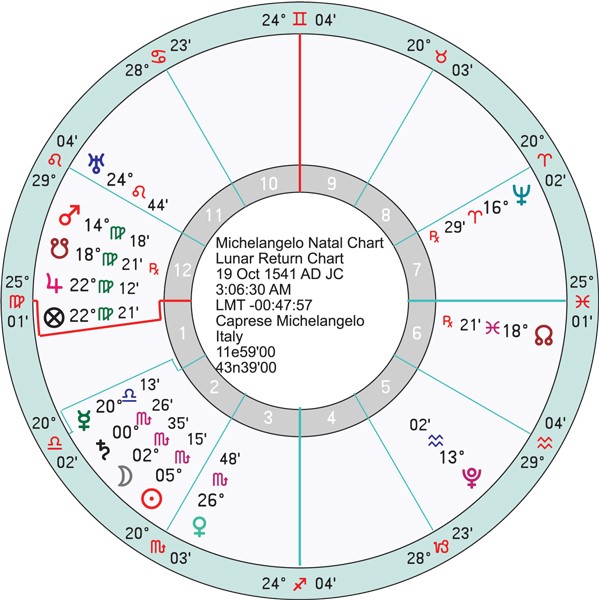
Lunar Return
Last Judgement opens to public
12 Dec 1541 AD JC
6:51:35 pm
Caprese Michelangelo
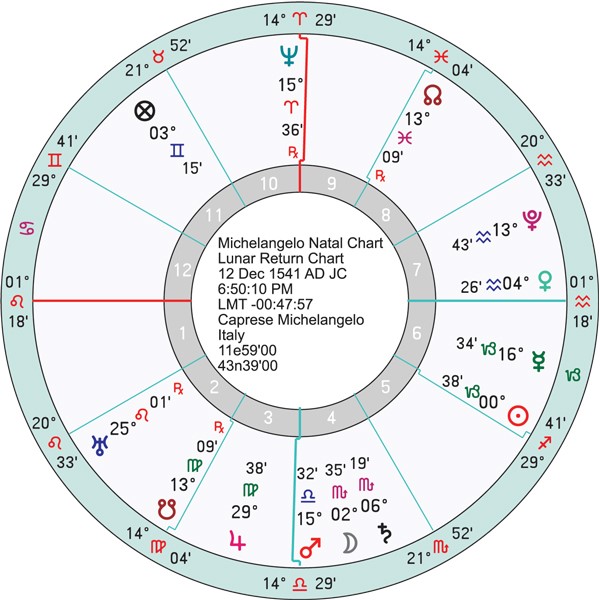
Event Chart
Last Judgement opened
25 Dec 1541 AD JC
12:00 pm
Rome
Italy
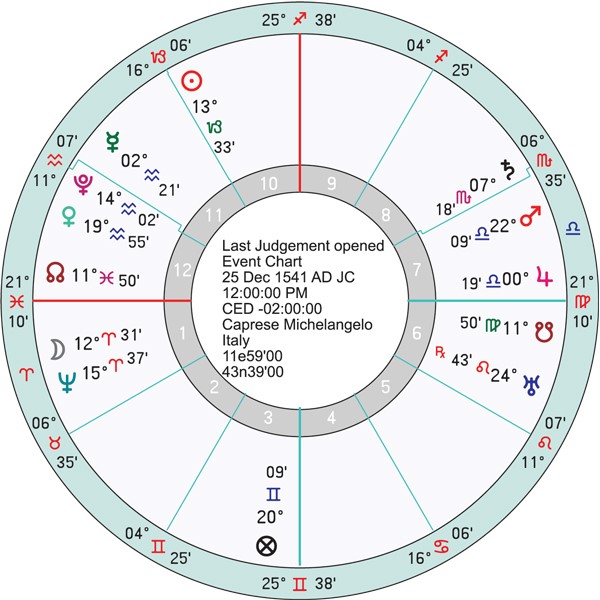
References:
Lives of the Most Excellent Sculptors, Painters and Architects Giorgio Vasari (1568) (George Bull translation)
Life of Michelangelo Ascanio Condivi (1553) (C B Holroyd translation)
The Fixed Stars and Constellations in Astrology Vivian Robson (1923)
Christian Astrology William Lilly (1647)
The Beginning of Wisdom Abraham Ibn Ezra (12th Century)
Extracts of Michelangelo’s poetry from Michelangelo Poems and Letters Penguin classics (Translated by Anthony Mortimer 2007)
About Author: Andrew McDonald studied Traditional Astrology extensively with John Frawley and is recognised as a Horary Craftsman and Craftsman Astrologer. He specializes in Horary, Natal and Electional Astrology. For Astrological consultations contact Andrew at andrew.mac@virgin.net or visit http://www.andymcdonaldartist.com Andrew is also an artist. His paintings fuse time, place and person and thus reflect the archetypal narrative of life.
Source: Saptarishis Astrology – saptarishisshop.com




